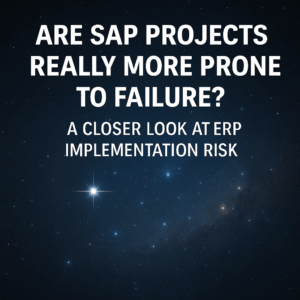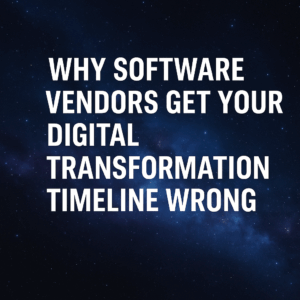The US Navy, one of the largest organizations in the world, embarked on an ambitious ERP implementation project with the lofty goal of consolidating all its disparate legacy systems onto a single SAP platform. Initially, the approach involved conducting pilots across four different areas of the organization to test SAP implementations. However, this decentralized approach led to isolated implementations lacking coordination, resulting in wasted resources and operational inefficiencies.
Recognizing the need for a course correction, the Navy pivoted to an enterprise-wide SAP implementation, impacting nearly 90,000 employees and involving complex integrations with dozens of legacy systems. Despite efforts to streamline the project scope to manage costs and timelines, the implementation encountered significant challenges and delays, casting doubt on its eventual success.

Table of Contents
ToggleThree Key Lessons Learned from this ERP Failure
In analyzing the details of this case study, three important patterns and failure points emerged. These appear to be some of the root causes for this catastrophic ERP implementation.
1. Clear Business Requirements
At the heart of the US Navy’s ERP failure was the absence of unified business requirements spanning the entire organization. Organizations embarking on digital transformation initiatives must invest significant time and effort upfront to meticulously define and prioritize requirements. These requirements serve as a roadmap for technology selection and implementation, guiding stakeholders toward a common vision of success.
Effective requirements gathering involves not only identifying functional needs but also considering organizational culture, existing processes, and future growth plans. Stakeholder engagement and alignment are critical in this phase to ensure that all perspectives are incorporated into the requirements-gathering process.
Moreover, prioritizing requirements based on business value and feasibility helps organizations focus their efforts on critical areas and manage resource allocation effectively. By establishing a robust requirements management framework, organizations can lay a solid foundation for a successful ERP implementation.
2. Robust Change Management
With sweeping changes affecting the entire organization, effective change management becomes paramount. Investing in robust change management strategies helps mitigate resistance and ensures the successful adoption of new systems and processes. By involving stakeholders early and addressing concerns proactively, organizations can navigate the complexities of change and pave the way for smoother implementations.

In addition to proactive communication and stakeholder engagement, organizations should leverage change management tools and methodologies to support employees throughout the transformation journey. Training programs, workshops, and other educational resources can empower employees to embrace new technologies and workflows. Moreover, fostering a culture of openness and transparency encourages employees to voice their concerns and participate in the change process, fostering a sense of ownership and commitment to the transformation effort.
Furthermore, change management should be an ongoing process, evolving alongside the project to address emerging challenges and opportunities. Regular communication, feedback mechanisms, and performance monitoring enable organizations to adapt to changing circumstances and ensure sustained momentum toward project goals.
3. Strong Program Management
Managing a project of such magnitude requires a centralized program management office (PMO) to oversee multiple workstreams, system integrators, and project components. A robust PMO ensures proper governance, controls, and alignment with project goals. By establishing clear lines of communication and accountability, organizations can minimize risks and maximize the chances of project success.
The role of the PMO extends beyond traditional project management functions to encompass strategic planning, risk management, and performance monitoring. It serves as the backbone of the project, providing leadership, guidance, and support to all stakeholders involved. Through regular status updates, milestone tracking, and issue resolution, the PMO ensures that the project stays on track and delivers the intended outcomes.
Furthermore, the PMO plays a crucial role in fostering collaboration and coordination among different teams and stakeholders. By promoting a culture of transparency and accountability, the PMO enables effective decision-making and problem-solving, ultimately driving project success. Additionally, the PMO serves as a centralized repository of project information, ensuring that all stakeholders have access to relevant data and insights.
In summary, a strong PMO is essential for managing complex ERP implementations and mitigating the risks associated with such projects. By providing leadership, guidance, and support, the PMO helps organizations navigate challenges and achieve their digital transformation goals.
Looking Ahead
The US Navy’s ERP failure serves as a sobering reminder of the challenges inherent in digital transformation initiatives. While failures can be costly and disruptive, they also offer invaluable opportunities for learning and improvement. By studying the missteps of others and embracing key lessons, organizations can chart a course toward digital transformation success.
Moving forward, organizations must prioritize clear business requirements, robust change management, and strong program management to navigate the complexities of ERP implementations successfully. By investing in these critical areas, organizations can mitigate risks, enhance project outcomes, and drive sustainable growth.
Conclusion
In the ever-evolving landscape of digital transformation, the journey is often fraught with challenges and uncertainties. However, by learning from past failures and leveraging best practices, organizations can navigate the complexities of ERP implementations with confidence. As we continue to push the boundaries of innovation and technology, let us remember that failure is not the end but rather a stepping stone towards greater success.
By embracing lessons learned from the US Navy’s ERP failure and applying them to their own initiatives, organizations can position themselves for success in the digital age. Through collaboration, innovation, and a commitment to excellence, organizations can overcome obstacles and achieve their digital transformation goals.
The US Navy’s ERP failure offers a valuable opportunity for reflection and growth. By heeding the lessons learned and adopting a proactive approach to digital transformation, organizations can pave the way for a brighter and more resilient future.





